Development of the NZ Dairy Industry
A few cows to global powerhouse in 200 years.
While we’re not all directly involved in the dairy industry, most of us are indirectly involved, or at least affected by it. Let’s take a look at how its developed over 200 years.
Since the early 1800’s the dairy industry in New Zealand has gone from farmers keeping a few domestic cows on bush blocks to now being a world leader accounting for 3% of total world production (not bad considering we only account for 0.06% of global human population)!
Shorthorns were the first dairy cows to arrive in NZ in 1814, with herds established by the early 1840’s, providing milk, butter and other dairy products to nearby towns. They were grazed on pastures cut out of native bush and were milked in the paddock, restrained with a leg rope or halter while the farmer sat on a stool or upturned bucket. This was a very labour intensive and slow process, but as they were only supplying small local demand and the occasional export to Australia, it sufficed.
With the advent of refrigeration in the 1880’s, export opportunities arose. The first dairy factories in Taranaki and Waikato were created, with twenty having been built by 1884.

Chew Chong’s general store in New Plymouth. He opened one of NZ’s first dairy factories in Taranaki in 1887.
Farmers took their milk to the local factory in metal cans on the back of horse-drawn carts. Factories played an important role in the development of dairying and showed how useful technology could be to farmers.
The creamery system
In the late 19th century butter factories grew larger, but it was difficult for farmers to transport milk more than a few miles to be processed. As a solution, small skimming stations were built on the outskirts of factories’ regions, where farmers could bring their cans of milk each morning, and the cream was separated, then transported to the central dairy factory by truck or boat. This creamery system operated from about 1880 to 1920.
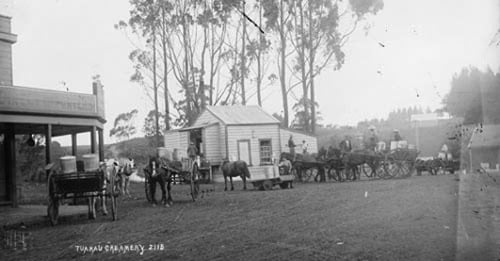
These farmers are waiting at the Tūākau creamery in the early 20th century. Although it could be monotonous, the time spent at the skimming station gave farmers the opportunity to discuss farming ideas and methods, politics, and, no doubt, the weather.
The other solution was the invention of the first cream separator in 1877 by Swedish engineer Gustaf de Laval. It enabled farmers to separate their own milk and sell the cream to dairy factories, rather than taking milk to a skimming station. The major advantage was that only about 10% of the volume of milk had to be transported to the factory. However, the change from skimming stations to on-farm separation was slow.
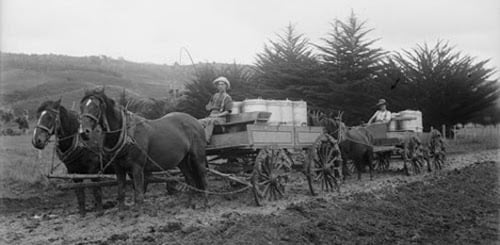
Delivering milk to skimming stations was difficult on long, unpaved country roads. These Northland farmers are making the daily milk run about 1910.
As road transport improved, cream could be collected more regularly, and more milk was separated on farms. By 1918, 24,700 farms (71%) supplied cream to dairy factories. In the 1930s and 1940s a cream truck called at each farm every one or two days to collect cream cans and return empty ones. Cream cans were a fixture until 1951, when factories once again required whole milk, and the first large tanker collections began.
Expansion of dairying
Dairy farms proliferated in the early 20th century as bush was cleared, land drained, and pasture improved with superphosphate fertiliser and faster-growing grasses and clovers.
Dairying was developed in regions where rainfall was reliable, and winters were warmer, such as Northland, Waikato, Taranaki, Bay of Plenty, Manawatu, Nelson and the West Coast.
In the 1930s Bill Gallagher in Hamilton invented low-voltage electric fencing, which allowed for better rationing of pasture and herd control.
Only 10% of the world’s dairy cows live solely on grazed pasture. This is an important advantage of the New Zealand dairy industry. New Zealand has a climate that, in most regions, grows grass year-round, and is mild enough that cows can be kept outside in all seasons. This means that the cost of feeding and caring for dairy cows is lower than anywhere else in the world.
Transport
The transportation of milk to factories, and dairy products to markets, was critical to the industry’s rate of expansion. In Waikato and Northland, river boats and barges carried milk and cream to factories. Coastal ships took goods to markets around the country, or to Wellington for export.
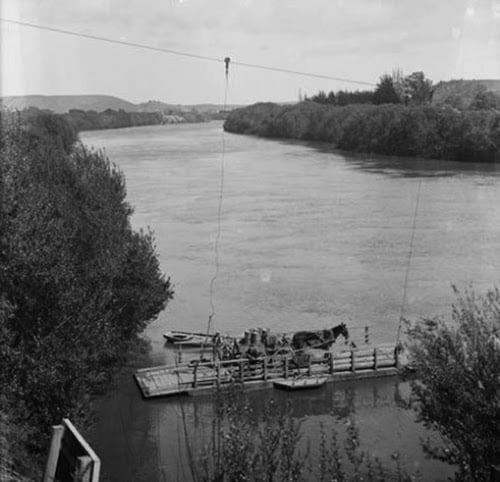
Country roads were rough, and bridges were few. Barges were essential for transporting produce in remote areas.
Some shortcomings in transport slowed the dairy industry’s growth. Delays in the spread of refrigerated equipment meant that for a long time dairy products travelled as ordinary cargo, without refrigeration. Many dairy factories were not near ports so awaited rail links, refrigerated wagons and storage to expand. The frozen-meat industry had similar needs, which accelerated the building of rail lines and the availability of refrigerated wagons. By 1892, 113 ventilated cool trucks were available for transporting dairy produce, with factories built along the rail network.
Centralisation
The number of factories peaked at about 600 in 1920 – about 85% of which were cooperatives. From then on, more efficient transport and economies of scale in processing led to larger factories and the closure of smaller ones.
In the 1930s there were 240 cooperative dairy companies in New Zealand. Through amalgamations and takeovers, they declined in number to 230 in the 1940s, 220 in the 1950s, 100 in the 1960s, 90 by the 1970s, and 36 in 1983. In 2008 there were only three: Fonterra, Westland and Tatua.
Milking systems
Owning more than three or four cows turned farming families into full-time dairy workers. It was time-consuming to care for cows and calves, do the milking, separate out the cream and drive it to the factory. The laborious business of hand milking created the demand for mechanical help.
The first milking machines were built in Europe in the 1890’s, and a Scottish model was trialled in Māngere, South Auckland, in 1893. They proved much more efficient than hand milking, and kept the milk enclosed and safe from contamination. Mechanical milking was the main reason for the increase in cow numbers and herd sizes from the beginning of the 20th century.
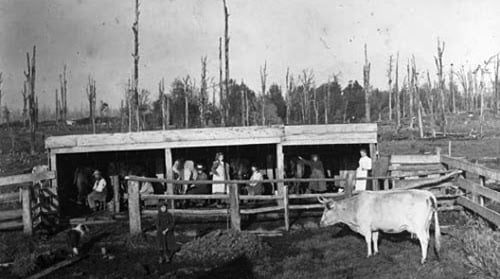
Stratford, Taranaki, around 1890. This milking shed was a distinct improvement on open-air milking as it provided shelter, and bails for cow restraint, but was very labour intensive and resulted in a stiff neck due to the lack of a raised platform.
Until the 1920’s and the introduction of auditing, dairy sheds had poor drainage and hygiene (see manure pile beside fence in photo above, manually removed from shed). Walk-through bails developed into ‘Pit Parlours’ which had raised platforms to make milking easier.
The Herringbone shed was invented in the 1950’s by Waikato farmer Ron Sharp, who combined the pit parlour with angled cow positions after seeing angle-parked cars on Hamilton’s main street. This design allows more cows to be milked at once by fewer people, and the cows walk in and out of the parlour by themselves.
The rotary milking platform was invented by Taranaki farmer Merv Hicks in the late 1960’s. Cows walk on and are milked, during one rotation, by operators standing outside the circumference of the platform. Cows back themselves off once the cups are removed and make their way back to pasture. Up to 1,000 cows can be milked in two or three hours by two people.
Both of these great Kiwi men had a huge influence on the operation of dairy farms globally through their inventions.
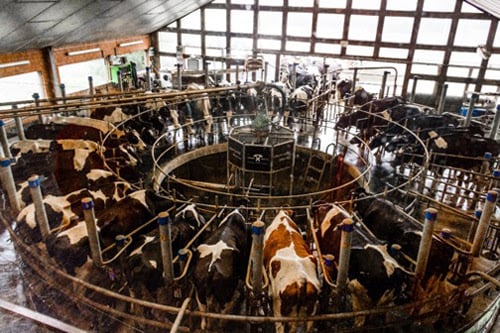
Modern rotary milking shed.
Robot milking - automatic milking machines run by a computer are used on some farms in Europe and North America. In 2007, this was trialled in Hamilton. Cows on pasture voluntarily walked to the milking shed once or twice in 24 hours and waited for their turn on the robot milker, all without human assistance.
Dairying in the 2000's
NZ dairy cattle population

The number of dairy cattle increased steadily in the early years of the 20th century as mechanisation and transportation improved. Numbers remained relatively static from the depression years of the 1930s through the Second World War until the mid-1970s. In the period from 1975 to 2005, increased fertiliser use, better pasture species, and expansion of dairying in the South Island all contributed to a steady increase in dairy cattle numbers.
In the early years of the 21st century dairying expanded onto irrigated farms on the Canterbury Plains and to Southland, where land prices were lower than in the traditional dairy regions of the North Island. By 2006 Waikato and Bay of Plenty had 32% of New Zealand’s dairy cows, Taranaki 12%, Northland 9%, and the South Island 28%.
From the 1970s many South Island farms were joined into bigger farms, which led to a reduction in the number of herds.
By 2007, farms were an average of 118 hectares and 322 cows, twice as large and twice the herd size as the early 1990s. There were approximately 4.2 million dairy milking cows, and 5.26 million dairy cattle in total, an increase from 3 million in 1982.
Dairy exports
In 1880, prior to the advent of refrigeration, the domestic market consumed the milk of only a few thousand cows, with exports of butter and cheese to Australia comprising only 0.17% of New Zealand’s total exports. The first export of refrigerated butter in 1882 changed the game - by 1890 dairy exports had increased to 7%, by 1920 this had risen to 22%, and in 1930 to 42%. In 2016, dairy accounted for 18% of total exports, with a worth of $12.4 billion, making it NZ’s leading export earner.
The New Zealand Dairy Control Board was created in 1923 to oversee group marketing, with the government assuming control for product marketing in 1934. The New Zealand Dairy Board was established in 1961 and operated as sole export marketer for 40 years. It grew from a dispatcher of butter and cheese to the UK to a multinational dairy foods company. To develop closer relationships with overseas markets, subsidiaries and joint ventures were formed. By 2001, investments in these had grown to around $1 billion, with 80 of them established and marketing products to more than 100 countries.
New Zealand sells 95% of its dairy products abroad, which is a greater proportion than any other country. The top five markets for NZ dairy exports are China, United States, United Arab Emirates, Australia, and Japan.
Only 3–4% of the world’s dairy products come from New Zealand. Most other countries produce their dairy products largely for domestic consumers.
Now a global powerhouse
The Dairy Group (Waikato) and Kiwi Co-operative (Taranaki) absorbed the New Zealand Dairy Board in 2001 to form Fonterra Co-operative Group. This was a significant step for New Zealand dairy manufacturing and marketing as it resulted in one major processing and marketing cooperative. It is now owned by 10,500 dairy farmers nationwide, processes 82% of the country’s milk (down from 96% in 2000 due to competitors growth in capacity), is responsible for approximately 30% of the world's dairy exports, and average annual revenue exceeds NZ$17 billion. The volume and reliability of Fonterra’s milk supply has made it one of the top 10 dairy companies in the world. It collects more than 13 billion litres of milk a year, sourced globally from farms in New Zealand, Australia, Chile, and China, with products sold in 140 countries. It has around 20,000 staff in 40 countries, with over half of its staff working outside New Zealand.

Fonterra Whareroa, near Hawera. In peak periods about 14 million litres of milk are processed daily.
The two dairy cooperatives that did not join Fonterra were Tatua Co-operative Dairy Company and Westland Milk Products. Tatua has since been at the forefront of the development of niche products. Westland has specialised in the production of milk powders, milk fats and milk protein products.
How have we been involved?
Waterworks are privileged to have been a part of this development, directly and indirectly, over the last 35 years.
In the 80’s we did a lot of precision engineering work at what was then Taranaki Farmers Fertilisers, now Ravensdown. This was in the developing years of fertilisers, when it was first becoming utilised.
In the 90’s we installed our first irrigation system on a dairy farm in Taranaki. It was a big deal and a bit of a new concept in the region, but proved popular, with a lot of the neighbouring farms following suit. Gary became a household name with dairy farmers in Taranaki due to his expertise with farm water, effluent, irrigation, and pumping solutions.
We grew as a business, and first started distributing PVC pipe and fittings to the agricultural sector nationwide in 2005. Elysee medium density compression fittings were a popular addition to the range, used for farm water systems throughout NZ.
In 2014 we started distributing Europress, which is used very extensively in dairy plants (and dairy sheds) for the likes of water, compressed air, glycol, and much more.
In 2016 we welcomed Spears Sch.80 PVC & CPVC to our range, which is used for detergent and sanitiser lines.
We consider it a privilege to have had our part in the development of this industry. Our time has served us well, placing us in a position where we can not only provide working solutions, but also make the pipeline installers job easier due to our wealth of experience on the coal face.
What will the next great development in the dairy industry be?
What are your thoughts on robotic milking?
How have you been involved so far?

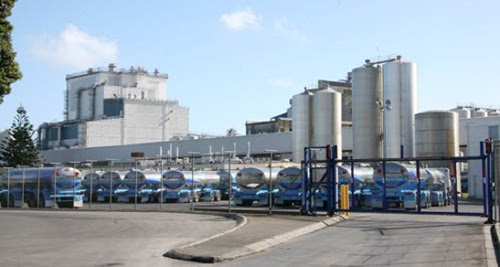

.png?width=352&name=Waterworks%20%20New%20website%20(1).png)
.png?width=352&name=Copy%20of%20WW%20%20Blog%20headers%202023%20(23).png)